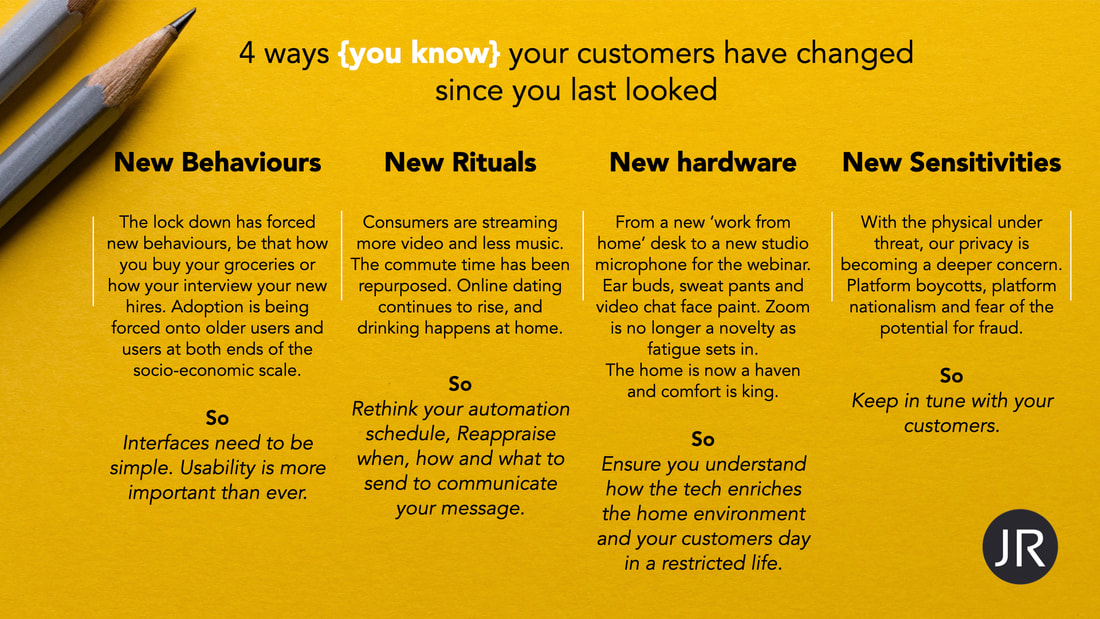|
In this article by Justin Anovick, The Chief Product Officer at Episerver outlines a incremental route-map of key steps to ecommerce maturity. Starting with a commerce minimum viable product (MVP). The Episerver product suite that Justin represents encompasses a wealth of advanced functionality, and at JumpRock, we have helped, business to business, clients understand how best to implement and utilise the advanced features of the Episerver enterprise platform. Using Episerver to talk specifically to their unique client base. As Justin outlines, core to developing a technology roadmap, one that will deliver the benefit your business requires, is having the basics of your platform in place. The core journey from product details to transacting, secondly an understanding of your customer segments, some core insights that will help you understand why this individual would choose to transact with you. Developing these base insights will help you understand the competitive advantage that you will be able to capitalise on. It is also important to understand, if and how this information has changed. We have just, globally been through a massive shift in how customers are able and willing to transact. Addressing how this may impact your optimal customer journey is key. Equally important is developing the clarity and buy in across your business. As an established B2B or B2C operation developing the digital processes required to deliver your product or service will undoubtedly require interactions with the wider business; logistics, manufacturing, supply chain, finance and marketing. Clarity and ‘buy in’ on business direction and a clear understanding of time to value will help you to add a layer of priority to the roadmap. Capitalising on not just, the ease of implementation, but applying a lens around the potential return on each optimisation activity. Your digital platform needs to be a treated as a revenue source and should not fall into the trap of becoming a cost centre. Having identified the key commercial opportunities and harnessing these against specific business KPI’s will provide a further input when constructing your roadmap. One that will keep it mindful of the complexity of your operation. Your roadmap needs to cut across silo’s recognising the input and complexity of working across the business and building a realistic plan that delivers against the opportunity and business objectives. We have experience of working with the Episerver platform and providing and executing strategic roadmaps to deliver business transformation. If you need help understanding your customer opportunity or developing a transformational roadmap that will pivot your Episerver commerce platform please do give us a shout for a free exploratory conversation. Third-party trademarks cited are the property of their respective owners, and are used only for reference purposes. Stephen GillespieCopyright JumpRock Consider the humble croissant. A mainstay of the continental breakfast. Wonderful paired with fresh butter, jam and a strong coffee. A great grab and go breakfast. If you want to stock up for home, you know where to go. At the supermarket, not far from the bread, in the baked goods section, next to the cakes and the speciality loaves like rye bread or ciabatta. The reason it’s there has a logic, in the supermarket the shelving configuration is the same as you need for speciality breads. In your mind there is a similarity in the production method, they are baked. And they sit there quite happily next to the bagels and sell in reasonable quantities. Psychologically we understand the supermarket we have been successfully conditioned to do so. Consider the following scenario. You are a café owner. Making an online order with your foodservice to fulfil your breakfast sitting tomorrow, you are ordering bacon, fresh tomato’s, coffee and possibly oranges for a fresh juice. The fresh croissants would provide a great option, an add on for the passing trade who drop in for a takeaway coffee. A great opportunity to increase the share of wallet, and something lighter for those not needing a full English. Engaging in the product conversation, at the point of consideration, where it makes the most sense to the customer. Supermarkets are expertly merchandised and behaviourally we know where our groceries are. We would find it incongruous to come across croissants in the bacon chiller. However, in the contextualised context of a café owner ordering volumes of stock for the breakfast sitting from a foodservice website the need for croissants is a very relevant conversation to be had whilst they are weighing up maple smoked bacon. In a b2b context successful merchandising is a key driver of share of wallet. Primary considerations around taxonomy andnavigation are important, (Croissants sit under baked and breakfast categories). For some organisations delivering the contextual connections can be as simple as drawing up a matrixed relationship and making careful use of upsells and cross sells within the sales journey. The matrix can be optimised and expanded upon using A/B tools over time. For a more complex product suite AI tools are the most effective way to manage a complex and sometimes layered set of product relationships at the scale required. The contextual relationship is vital to develop the customer experience and drive a higher order value. The relationship between croissants and bacon as well as jam need to be addressed. If the process is manual, starting simple is key. Build up knowledge based on results. It is too easy to get caught up in the complexity however drawing up a simple set of rules initially that can be refined over time is simpler to achieve than you think. It is possible to deliver an uplift with a simple rules-based approach. Refining and learning as you go. If you are not doing this already this route may be possible with the tools you are currently using without the need for extensive development. For AI driven merchandising there may be components within your existing application suite that can deliver significant results. I have seen quoted all be it unattributed statements that over 80 percent of executives in both the retail and consumer product industries expect to be using automated intelligence by 2021, whether this is true or not, it is a fact that AI is into the mainstream and achievable bought as a service without eyewatering investment. Merchandising your site involves thinking in the context of the site user. Is your head up and smelling the coffee at breakfast or are you nestled away from flow to the side of the baked goods? Stephen GillespieCopyright JumpRock Silo’s what did they ever do for us? Just days before lockdown, I started an engagement with a client. Luckily, I had managed to get a few face to face meet and greets before we went completely remote. My specific task was to work with stakeholders across the business to prioritise a large legacy of backlog features across different product offerings and teams. It was to understand the usual reporting and management procedures and understand how to use them within the initiative for creating buy in and provide project reporting engagement. As is usual for large business, each product line has its own targets and KPI’s and to a degree its own vision. Each team, and rightly so is very much focussed on hitting their targets and delivering the best features and functionality for their own individual areas. This by its very nature creates siloed thinking, which everyone understands can impact initiatives. Necessity is the mother of innovation! After barely a hello, Covid hit, and the organisation was forced to rewrite all its procedures and rapidly rethink its business and product strategy. The positive was a re-evaluation of the value of each of the usual interactions. The focus of the entire organisation shifted to what do we need now and what will we need in the future to create value. This kind of disruptive change often yields innovative solutions. But in my case, I feel the most valuable shift was the objectivity. Fortuitous for my project, which required a wholesale rethink of how the organisation presented its product offering. The refreshing objectivity allowed a clear focus on the roadmap of features and the future direction of the project within the context of a pivoting organisation. The project was to deliver a broad programme of platform improvements with a fixed level of technical resources. On-going backlog prioritisation was essential but in the first instance what was required was a common platform for understanding value. What was essential, was that collectively, across product lines, all the business stakeholders set, understood and agreed with how priorities were arrived at, based on one vision. A common language was used to express benefits, and these were understood and agreed upon at a collective level. Stakeholders had an easy means of understanding third party aspirations within the platform and could have empathy with priorities given to invisible parties within the organisation, site users or other visible and potentially competing groups. A shared and agreed platform created a consensus and facilitated the ease of delivering the digital products that would add real value in a rapidly evolving programme. Change is hard, and transformational change harder still. With the rapid and evolving shifts, we are experiencing at the moment the opportunity to understand clearly and collectively what is important now and moving forward is key. Breaking down silos is not easy. Having an outside lens facilitating this within your business has many benefits such as objectivity, clarity of vision and subject matter expertise, which JumpRock can provide. If you would like to understand how JumpRock can assist your teams break down your silo’s and facilitate transformational change, please do get in touch. We are happy to help. Mona RanjanCopyright JumpRock You’ve changed! But we all have. To save you having to do the thinking we’ve pulled together a quick slide outlining the immediate and obvious changes we can all attest to in the population, post covid. Download the slide and drop it into your next board deck. Cover up our JumpRock logo or keep it on there, it’s up to you. If you are using your PAAS/SAAS marketing platforms in the same way that you did pre Covid. It’s time to take a deeper look.
Stephen GillespieCopyright JumpRock We may be inching towards further restrictions that could affect many aspects of life, social and business. Collectively we have developed some experience of how to deal with this change following our first lockdown. And one thing we have learnt is that we now need to realise every opportunity. Before Covid, in a more 'multichannel' world, marketing was justifiably a multichannel activity. We prioritised finite marketing resources across a raft of performing channels. With live and face to face now curtailed, more of a focus is being placed on digital channels. Digital will no doubt has been invested in heavily in the past, with the implementation and integration of a variety of PAAS and SAAS systems to provide the functionality needed to deliver your marketing activity (You can see what I have previously written here about the need to reappraise how you are using your martech stack). If you are now marketing in the way you did when your platform was implemented, you are certainly missing an opportunity. PAAS and SAAS systems are constantly evolving delivering new opportunities to marketeers to personalise and tailor marketing to achieve precise objectives. One of our enterprise clients was engaged in providing a services through live events, not surprisingly traffic to that service fell away, as the product line had to be suspended in the first lock down. But opportunity was still there, thier free online resources were experiencing increased interest. There was traffic but no new income. Creating personalised connections targeted at bridging the gap between the free content and the readily available physical product lines, presented a fresh business opportunity that we were able to quantify at over £300,000 per month, if we assumed only a 1% migration of traffic. The huge positive was that the traffic, content and ecommerce opportunity was all happening on one platform. Reappraising how the platform was being used and a reprioritisation of existing resources opened up a whole new income stream. Very welcome in the current trading climate. A clear understanding of the current capability you have available and a good knowledge of your site visitors is marketing bread and butter but the point to remember is that the world and your consumers have changed massively in 2020. To assume that your clients and your platforms have not is closing off opportunity. The good news is that pivoting your business does not always require a redevelopment of your marketing stack. In our experience bringing how you are using it in line with your current market situation can deliver opportunity and release untapped revenue. What is essential is a clear and agreed appraisal of the opportunity and a shared understanding across your business that the pivot is justified and designed to address a clear business opportunity. At JumpRock our methodology includes the deployment of priority assessment tools. Understanding implementation cost, business opportunity, newly identified user requirements, estimated revenue and finally time to value. We ensure that when we produce a gated roadmap. We can work with your stakeholders making sure they can be confident that it is workable and justifiable for the whole business. Stephen GillespieCopyright JumpRock |
|||||||





 RSS Feed
RSS Feed